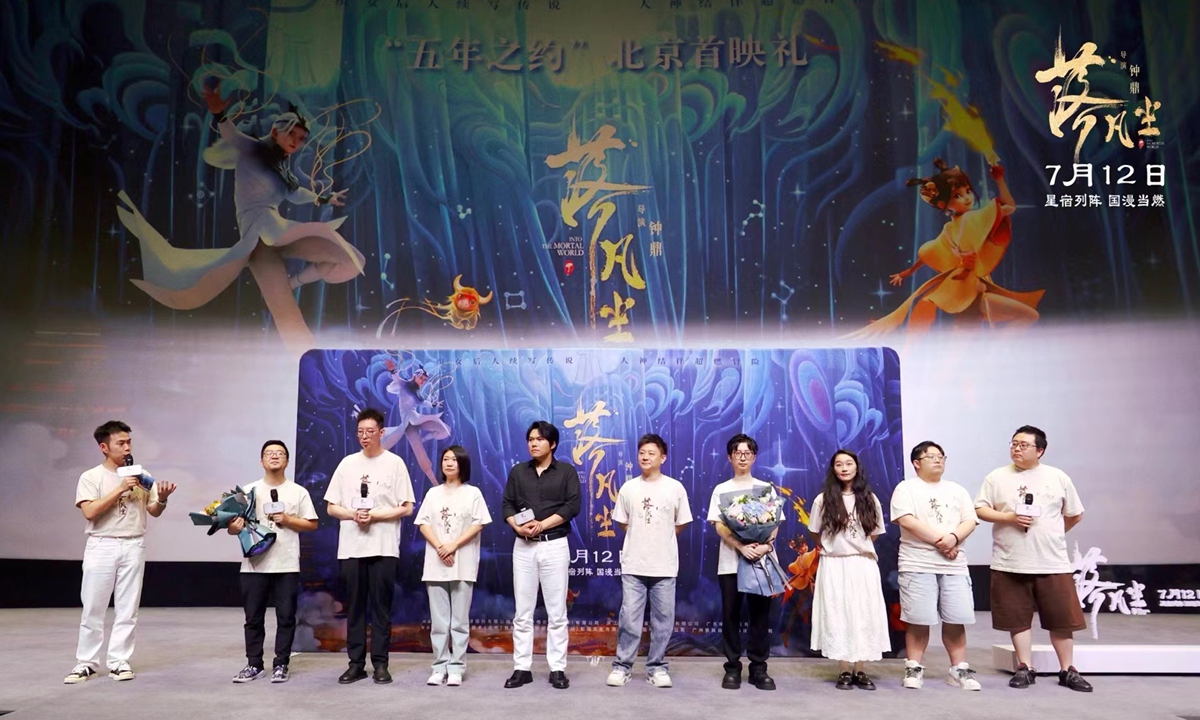
Photo: Courtesy of the production team of Into the Mortal World
The new Chinese-style animated film
Into the Mortal World is set to debut in cinemas on Friday. Amid the rising popularity of China Chic among today's youth, the film revolving around the traditional Chinese culture and family values has captured great attention and has been seen as an envoy promoting and reviving Chinese culture.
Adapted from the folk tale The Cowherd and the Weaver Girl, also known as Niulang and Zhinü in Chinese, which can be traced to over 2,000 years ago, the animated film creatively presents a portrait of the descendant of the two leading roles in the traditional folktale, while going to great effort to incorporate Chinese cultural elements such as Chinese constellations and face-changing art into the story.
The familial bond between family members is the main value that this film aims to convey, Zhong Ding, director of the movie, told the Global Times on Thursday.
The film centers around the adventures of Jinfeng, who debuts as a frustrated apprentice of the God of War and is bullied by his peers since his mom is Zhinü, the Goddess of Weaving and the "Weaver Girl" from the tale who rebelled against Heaven's rule that it is forbidden for gods to fall in love and build a family with mortals.
The animated film features traditional Chinese elements such as lanterns, dragon dances, embroidery, and celestial beings.
In the film, the divine realm's architecture draws inspiration from Anhui-style buildings, while the use of color in the movie follows the traditional Chinese painting technique of leaving broad, blank spaces in a painting.
Additionally, it incorporates contemporary popular elements such as hot pot, bubble tea, billboards, and bullet screens in a natural way.
"Our design principle was presenting modern concepts with ancient materials and craftsmanship, ensuring the audience remains immersed in the story," Zhong noted.
For instance, billboards in the film are created using various lanterns, and bullet screens are driven by water wheels and presented via scrolls.
Some niche parts of traditional Chinese culture are concretely presented and draws audiences' attention through slickly-executed scenes produced by dozens of art designers, according to the film's producer at a premiere held in Beijing on Wednesday. The Twenty-Eight Mansions throughout the film is just one example of this.
The film originated from a short film of the same name from the Guangzhou Academy of Fine Arts that went viral four years ago.
Zhong, an associate professor at the academy, led 13 students in creating the graduation project.
Over the past five years, more than 2,000 animators from over 50 teams collaborated to transform the original student project into this new Chinese-style animated film.
"My biggest hope is that the film will be seen by as many people as possible," Zhong remarked.
According to Zhong, to align the ancient folk tales with the tastes of modern audiences and contemporary trends, the film goes beyond traditional mythological narratives.
In the movie, Zhinü is depicted as capable, balancing family care with independent thought, aligning with modern portrayals of women. Niulang, although a mere mortal, is shown as simple and kind, willing to sacrifice his life to protect his family.
The film also has plans for an international release.
"What is national is also global. I believe that even if foreign audiences are unfamiliar with ancient Chinese mythology, they can still appreciate the beauty of Chinese culture and understand the family values conveyed in the film," Zhong told the Global Times.




